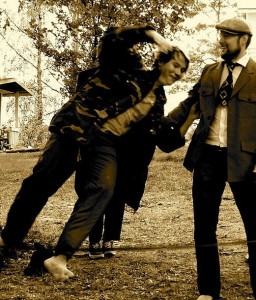About ten years ago I was killing time in the sprawling Barnes & Noble on Union Square in Manhattan. I had pushed my chair away from a little table, crossed my legs, and opened a book on my lap. I don’t remember which book. I can’t even remember whether it was one I’d grabbed off a shelf or, because I was deep in research at that time, one I’d been carrying around all day just in case I found myself with a few free minutes. I do remember that I was trying to understand what gravity is. Or, as I was beginning to appreciate, isn’t.
Because I don’t have a background in science, I pretty much have to start from scratch when I’m researching a topic. In my investigations into gravity, I’d already discovered that Isaac Newton had been making it up as he went along, and that he had admitted as much in one of his letters to the theologian Richard Bentley. The notion of a force of attraction existing between two distant objects, he wrote, is “so great an Absurdity that I believe no Man who has in philosophical Matters a competent Faculty of thinking can ever fall into it.” Yet fall into it subsequent generations of physicists did. Nearly two centuries later, the German philosopher-scientist Ernst Mach wrote, “The Newtonian theory of gravitation, on its appearance, disturbed almost all investigators of nature because it was founded on an uncommon unintelligibility.” Now, he went on, “it has become common unintelligibility.”
One of Mach’s greatest admirers, Albert Einstein, thought a lot about that unintelligibility, and in his equations for general relativity he reconceived gravity not as some mysterious force that acts across space but as a property that belongs to space. In Newton’s physics, space is passive, a vessel for an interaction between masses. In Einstein’s physics, space is active, collaborating with matter to produce what we perceive as gravity’s effects. The Princeton physicist John Archibald Wheeler offered possibly the pithiest description of this co-dependence: “Matter tells space how to curve. Space tells matter how to move.”
Still to come for me, relative to that evening in Barnes & Noble, were visits to experiments testing Newton’s and Einstein’s equations. On the scale of the very small, I learned, scientists until recently hadn’t managed to measure gravity at ranges shorter than a millimeter. “Astonishing, isn’t it?” one physicist said to me, leading me on a tour of the table-top, jewel-box experiments at the Eöt-Wash Group lab at the University of Washington, Seattle. “But it wouldn’t be astonishing if you tried to do it.” Testing gravity at small distances isn’t simply a matter of putting two objects close to each other and measuring the attraction. The experimentalist has to take into account everything else that might be exerting a discernible gravitational influence: the other experiments in the lab, the groundwater level outside the building, the position of the Sun and the Moon.
 Then, to witness a test of Einstein on the scale of the very large, I visited the Apache Point Observatory Lunar Laser-ranging Operation (APOLLO) in the Sacramento Mountains of New Mexico. At the rate of twenty pulses a second, a laser was bouncing beams off the Moon—or, more accurately, off one of the four suitcase-size mirrors that Apollo astronauts had planted on the lunar surface four decades earlier specifically for this kind of experiment. By timing the speed-of-light round-trip journey, researchers could determine the distance to the Moon moment by moment to within a millimeter. As in the apocryphal story of Galileo dropping balls from the Leaning Tower in Pisa to test the universality of free fall, the laser-beam experiment treats the earth and moon as two balls dropping in the gravitational field of the sun.
Then, to witness a test of Einstein on the scale of the very large, I visited the Apache Point Observatory Lunar Laser-ranging Operation (APOLLO) in the Sacramento Mountains of New Mexico. At the rate of twenty pulses a second, a laser was bouncing beams off the Moon—or, more accurately, off one of the four suitcase-size mirrors that Apollo astronauts had planted on the lunar surface four decades earlier specifically for this kind of experiment. By timing the speed-of-light round-trip journey, researchers could determine the distance to the Moon moment by moment to within a millimeter. As in the apocryphal story of Galileo dropping balls from the Leaning Tower in Pisa to test the universality of free fall, the laser-beam experiment treats the earth and moon as two balls dropping in the gravitational field of the sun.
So far Einstein was holding at both ends of the length scale. “He’s always smarter than you think,” the theorist Sean Carroll once said to me—and he should know. Like many theorists, he has devoted part of his career to trying to figure out alternative interpretations of gravity. Is it leakage from another universe? Was Einstein’s math insufficient on length scales we can’t yet reach? When—if—we reconcile quantum mechanics and general relativity, will what we think of as gravity turn out to be an artifact of a fundamental misunderstanding of physics?
I now know that when I sat down in that Barnes & Noble, I was at a moment in my research midway between complete ignorance about gravity and a deep respect for its enduring mystery. Gravity, I remember thinking as I looked up from the book, is just a word! Something to call a certain effect until we know more about it! Even so, I can say in retrospect that at that moment my appreciation of what gravity is—or isn’t—was still only intellectual.
 I looked at my watch. I was running late for an appointment—or, as I couldn’t help thinking that evening, I was at the wrong point on the space-time continuum. I closed the book and stood up, but not quite. My left foot, the one that had been flat on the floor for the past half-hour, was asleep. I am nearly six-six; I don’t drop gently.
I looked at my watch. I was running late for an appointment—or, as I couldn’t help thinking that evening, I was at the wrong point on the space-time continuum. I closed the book and stood up, but not quite. My left foot, the one that had been flat on the floor for the past half-hour, was asleep. I am nearly six-six; I don’t drop gently.
My fall silenced the customers in my vicinity, then prompted an outpouring of concern. But even as I tried to hold on to the edge of the tabletop as well as my dignity, I felt an exquisite satisfaction. It came from the realization that I’d reached a new understanding of gravity. I had learned my lesson, and it was a lesson that resonated not only on an intellectual but on a visceral level, and it was the same lesson every physicist has to learn: You take gravity for granted at your own peril.
* * *
Image credits (top to bottom): Beyond My Ken; NASA; Ville Miettinen.

Delightful on many levels.“Matter tells space how to curve. Space tells matter how to move.”–how sexy is that???? What really inspires me most in this column is the artist’s do-it-yourself spirit, the courage of the will to find out without extraordinary technical training or initiation into the priesthood of physics. You make me feel that I, too, could get a better grip on gravity (or other scientific topics) if I would just approach it with an open mind and focused attention.
I had a gravity-moment too, Richard. We’d had an ice storm and I’d told my traveling neighbor I’d check her house which was across the street. The street runs down a hill, not steep, but I could NOT walk across it, I just slid down the street. My husband-the-physicist said, “See, I told you friction was important.” All I could think was that gravity was even more so.